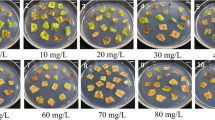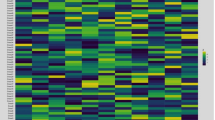Abstract
Haploid mutagenesis offers several advantages over conventional (seed) approach. However, its potential has not been utilised for Brassica juncea, an important oilseed. In this study, mutant donor plants of three Indian B. juncea genotypes, generated by ethyl methanesulfonate (EMS) and ethyl nitrosourea (ENU), were used for microspore culture. The response of mutant donor plants was about 100 times lower than non-mutant controls; a total of 9,411 embryos were produced from the EMS treated donor plants, while microspores isolated from ENU treated donors did not yield any embryos. The lethality of induced mutations demonstrated itself mainly as the induction of abnormal embryos (80%), failure of germination (70%) and failure of plantlet development (70%). Nine doubled haploid (DH) mutant lines and three non-mutant DH lines obtained through this approach were tested for agronomic and biochemical variation over two growing seasons. High variability was observed and stable mutants were recovered for reduced height (125 vs. 168 cm for the control), appressed pod character, altered fatty acid composition higher protein proportion in de-oiled meal (48%) and a lower glucosinolate content in de-oiled meal (59.5 μM/g) relative to controls. The approach demonstrates that despite severe reduction in efficiency of the DH line production, valuable mutants can be recovered from mutated donor plants.







Similar content being viewed by others
References
Agnihotri A, Prem D, Gupta K, Sarkar G (2007) The chronicles of oil and meal quality improvement in oilseed rape. In: Gupta SK (ed) Oilseed rape breeding. Elsevier Publishers Academic Press, New York, pp 49–97
Agnihotri A, Gupta K, Prem D, Sarkar D, Mehra VS, Zargar SM (2009) Genetic enhancement in rapeseed- mustard for quality and disease resistance through In vitro techniques In: Burton W, Norton R, Worthy A (eds) Proceedings of 14th Australian Research Assembly on Brassica, Ballart, Australia, 14–16th Sep., pp 64–69
Ahuja KL, Labana KS, Raheja RK, Badwal SS (1984) Oil content and fatty acid variation in mutants of Brassica juncea. J Oilseeds Res 1:71–75
Barro F, Fernandez-Escobar J, de la Vega M, Martin A (2001) Doubled haploid lines of Brassica carinata with modified erucic acid content through mutagenesis by EMS treatment of isolated microspore. Plant Breed 120(3):262–264
Beaith M, Fletcher R, Kott LS (2005) Reduction of saturated fats by mutagenesis and heat selection in Brassica napus L. Euphytica 144:1–9
Bhatia CR, Nichterlein K, Maluszynski M (1999) Oilseed cultivars development from induced mutations and mutation altering fatty acid composition. Mut Breed Rev 11:1–36
Chanana NP, Dhavan V, Bhojwani SS (2005) Morphogenesis in isolated microspore culture of Brassica juncea. Plant Cell Tiss Organ Cult 83:169–177
Cloutier S, Cappadocia M, Landry BS (1995) Study of microspore culture responsiveness in oilseed rape (Brassica napus L.) by comparative mapping of a F2 population and two microspore derived population. Theor Appl Genet 91:841–847
Das ML, Rehman A (1988) Induced mutagenesis for the development of high yielding varieties in mustard. J Nucl Agric Biol 17:1–4
Downey RK (1990) Brassica oilseed breeding—achievements and opportunities. Plant Breed Abstr 60(10):1165–1170
Downey RK, Rimmer SR (1993) Agronomic improvements in oilseed Brassicas. In: Sparks DL (ed) Advances in agronomy, Vol. 50. Academic Press, New York, pp 1–66
Federer WT (1956) Augmented (or hoonuiaku) designs. Hawaiian Planters Record 2:191–208
Ferrie AMR, Caswell KL (2010) Isolated microspore culture techniques and recent progress for haploid and doubled haploid plant production. Plant cell tissue and organ culture doi:10.1007/s11240-010-9800-y
Ferrie AMR, Taylor DC, Mackenzie SL, Rakow G, Raney JP, Keller WA (2008) Microspore mutagenesis of Brassica species for fatty acid modifications: a preliminary evaluation. Plant Breed 127:501–506. doi:10.1111/j.1439-0523.2008.01502.x
Gamborg OL, Miller RA, Ojima K (1968) Nutritional requirements of suspension cultures of soybean root cells. Exp Cell Res 50:151–158
Gomez K, Gomez AA (1984) Comparison between treatment means. In: Statistical procedures for agriculture research, 2nd edn. IRRI publication, New York, pp187–240
Hedden P (2003) The genes of the green revolution. Trends Genet 19:5–9
Jambhulkar SJ (2007) Mutagenesis: generation and evaluation of induced mutations. In: Gupta S (ed) Advances in botanical research, Vol. 45, incorporating advances in pathology. Elsevier Ltd., Amsterdam, pp 418–428. doi: 10.1016/S0065-2296(07)45014-5
Kaushik N, Agnihotri A (1997) Evaluation of improved method for determination of rapeseed-mustard FAMES by GC. Chromatographia 44:97–99
Khan AJ, Hassan S, Tariq M, Khan T (2001) Haploidy breeding and mutagenesis for drought tolerance in wheat. Euphytica 120:409–414
Kirk JTO, Oram RN (1981) Isolation of erucic acid free lines of Brassica juncea: Indian mustard now a potential oilseed crop in Australia. J Aust Inst Agric Sci 47:51–52
Kott LS (1998) Application of doubled haploid technology in breeding of oilseed Brassica napus. Agbio News Inf 10:69–73
Kott LS, Wong R, Swanson E, Chen J (1996) Mutation and selection for improved oil and meal quality in Brassica napus utilizing microspore culture. In: Jain SM, Sapory S, Velleux RE (eds), In vitro haploid production in higher plants Vol. 2, Springer, Berlin, pp 151–167
Kumar S, Yadav SK, Chauhan IS, Singh AK, Khan NA, Kumar PR (2004) Total glucosinolate estimation by complex formation between glucosinolate and tetrachloropalladate (II) using ELISA reader. Food Sci Technol 41:63–65
Labana KS, Chaurassia BD, Singh B (1980) Genetic variation and association studies on some quantitative characters in mutants of Indian mustard (Brassica juncea (L.) Czern and Coss. Indian J Agric Sci 50:803–816
Maluszynski M, Szarejko I, Sigurbjornsson B (1996) Haploidy and mutation technique. In: Jain SM, Sapory S, Velleux RE (eds) In vitro haploid production in higher plants, vol 1. Kluwer Academic Publishers, Netherlands, pp 67–93
Murashige T, Skoog F (1962) A revised medium for rapid growth and bioassay with tobacco tissue cultures. Physiol Plant 15:473–497
Nayar GG, George KP (1969) X-ray induced early flowering, appressed pod mutant in Brassica juncea. In: proceedings of international symposium, radiation and radiomimetic substances in mutation breeding, 26–29 Sep. Bombay, India. pp 409–413
Oram RN, Salisbury PA, Krick JTO, Burton WA (1999) Development of early flowering, canola grade Brassica juncea germplasm. In: proceedings of 10th international rapeseed congress, 26–29th Sep. 1999, Canberra, Australia
Palmer CE, Keller WA, Arnison PG (1996) Experimental haploidy in Brassica species. In: Jain SM, Sapory SK, Veilleux RE (eds) In vitro haploid production in higher plants, vol 3. Kluwer, Dordrecht, pp 143–172
Prem D (2006) Induction of genetic variability for agro-morphological and biochemical traits in Indian mustard [Brassica juncea (L.) Czern and Coss] through chemical mutagenesis in conjugation with doubled haploid technology. PhD Thesis. TERI University, New Delhi
Prem D, Gupta K, Agnihotri A (2005) Effect of various exogenous & endogenous factors on microspore embryogenesis in Indian mustard (Brassica juncea [L.] Czern & Coss). In Vitro Cell Dev Biol-Plant 41(3):266–273. doi:10.1079/IVP2005636
Prem D, Gupta K, Agnihotri A (2008a) Doubled haploidy in crop brassicas: retrospect and prospects. In: Kumar A, Shekhawat NS (eds) Recent advances in Plant tissue culture and its applications. I. K. International Private Limited, New Delhi, pp 155–186
Prem D, Gupta K, Sarkar G, Agnihotri A (2008b) Activated charcoal induced high frequency microspore embryogenesis and efficient doubled haploid production in Brassica juncea. Plant Cell Tiss Organ Cult 93:269–282. doi:10.1007/s11240-008-9373-1
Prem D, Gupta K, Agnihotri A (2011) Can we predict mutagen induced damage in plant systems mathematically? Insights from zygotic embryo and haploid mutagenesis in Indian mustard (B. juncea). Botanica Serbica 35(2):139–145
Rai UK (1959) ‘Thickened pods’ a morphological recessive mutant in X-ray treated Brassica juncea. Sci Cult 24:534–539
Reddi MV, Reddy PS (1980) Chapter 20, Commercial crops- Oilseed crops. In: Jaiswal PL, Wadhwani AM (eds) Handbook of agriculture, 5th edn. Indian Council of Agriculture Research, New Delhi, pp 933–940
Robbelen G (1990) Mutation breeding for quality improvement. A case study for oilseed crops. Mutation Breeding Review, No. 6. FAO/IAEA Division of Nuclear Techniques in Food and Agriculture, Vienna
Singh KP, Sareen PK (2004) Induced podding mutants of Indian mustard (Brassica juncea L. Czern and Coss.). Cruciferae Newsletter 25:17
Sokal RR, Rohlf FJ (1981) Biometry: the principles and practices of statistics in biological research, 2nd edn. W. H. Freeman and Company, New York
Szarejko I (2003) Doubled haploid mutant production. In: Maluszynski M, Kasha KJ, Foster BP, Szarejko I (eds) Doubled haploid production in crop plants-a manual. Kluwer Academic Publishers, Netherlands, pp 351–361
Szarejko I, Guzy J, Jimenez Davalos J, Roland Chavez A, Maluszynski M (1995) Production of mutants using barley DH system. In: Induced mutations and molecular marker techniques for crop improvement. IAEA, Vienna, pp 517–530
Thurling N (1992) Physiological constrains and their genetic manipulations. In: Labana KS, Banga SS, Banga SK (eds) Breeding oilseed brassicas. Narosa Publishing House, New Delhi, pp 44–66
van Harten AM (1998) Mutation breeding: theory and practical applications. Cambridge University Press, London, pp 29–30
Velasco L, Fernandez-Martinez JM, de Haro A (1998) Increasing erucic acid content in Ethiopian mustard through mutation breeding. Plant Breed 117:85–87
Xu L, Najeeb U, Tang GX, Gu HH, Zhang GQ, He Y, Zhou WJ (2007) Haploid and doubled haploid technology. In: Gupta S (ed), Advances in botanical research, Vol. 45, incorporating advances in pathology, Elsevier Ltd., pp 182–208. doi: 10.1016/S0065-2296(07)45007-8
Zhang EL, Takahata Y (2001) Inheritance of microspores embryogenic ability in Brassica crops. Theor Appl Genet 103:254–258
Acknowledgments
The first author thanks TERI University for providing facilities for conducting this investigation as a part of his Ph.D. research work. We also thank Chandan Singh and Chandan Khimani for their assistance during the course of this work and Dr. Manohar Kahmira (Technische Universiteit Eindhoven) for help in graphics. Authors are grateful to the Indian Council of Agricultural Research, Government of India, for the grant of financial support for undertaking this work.
Author information
Authors and Affiliations
Corresponding author
Rights and permissions
About this article
Cite this article
Prem, D., Gupta, K. & Agnihotri, A. Harnessing mutant donor plants for microspore culture in Indian mustard [Brassica juncea (L.) Czern and Coss]. Euphytica 184, 207–222 (2012). https://doi.org/10.1007/s10681-011-0548-1
Received:
Accepted:
Published:
Issue Date:
DOI: https://doi.org/10.1007/s10681-011-0548-1




